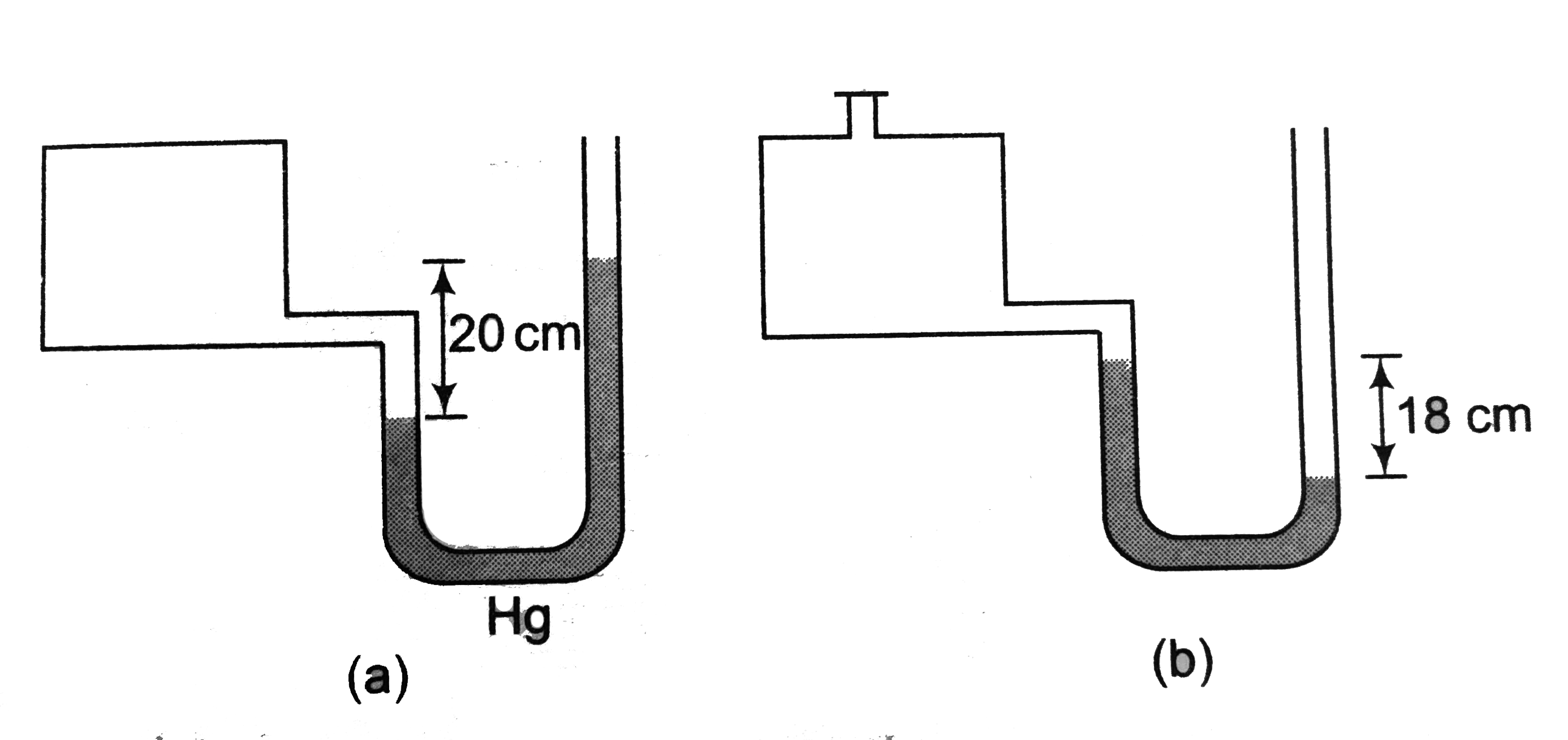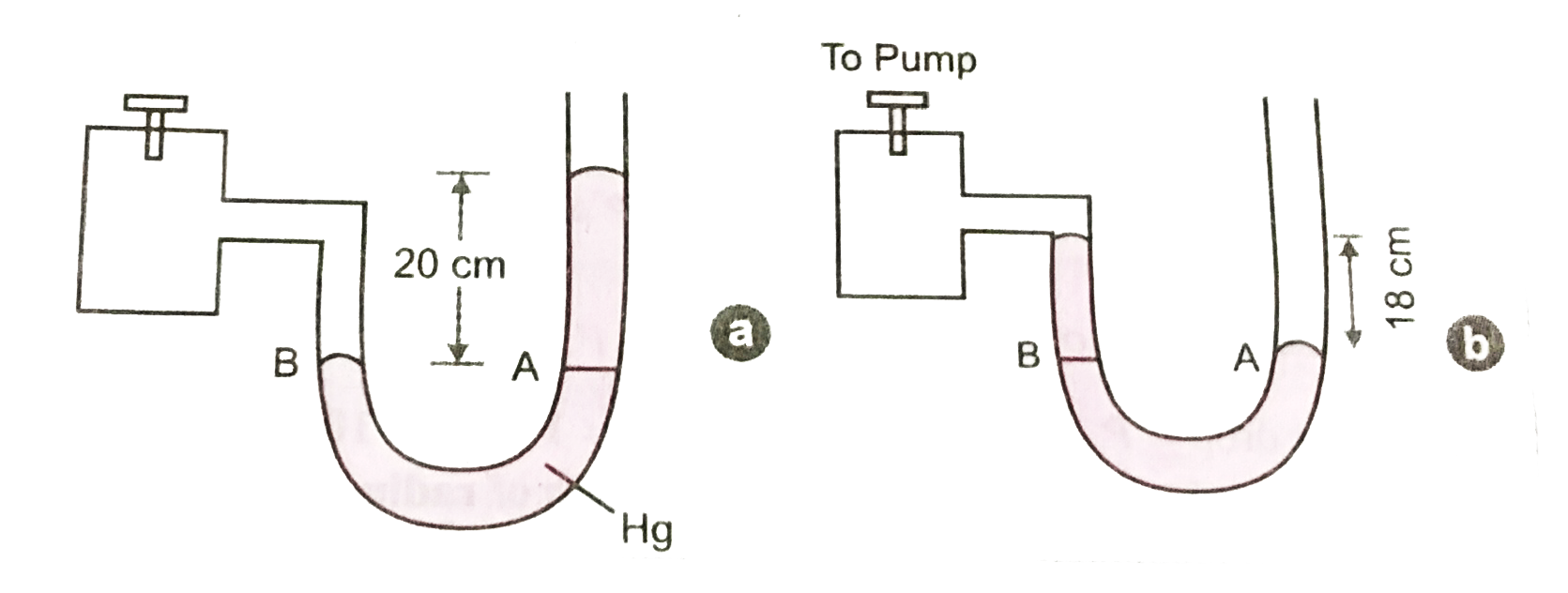A manometer reads the pressure of a gas in a enclosure as shown in figure(a) When some of the gas is removed by a pump, the manometer reads as in (b). The liquid used in the manometers is mercury and the atmospheric pressure is 76cm of mercury.

(i) Give the absolute and gauge pressure of the gas in the enclosure for cases (a) and (b) in units of cm of mercury .
(ii) How would the level change in case (b) if 13.6cm of water are poured into the right limb of the manometer?
The atmospheric pressure, P=76cm of mercury
(a). From figure (a)
pressure head, h=20cm of mercury
∴ absolute pressure =p+h=76+20=96cm of mercury
Also, gauge pressure =h=20cm of mercury
From figure (b),
Pressure head, h=−18cm of mercury
∴ Absolute pressure =p+h=76+(−18)=58cm of mercury
Also, gauge pressure =h=−18cm fo mercury
(b) When 13.6 cm of water is poured into the right limb of the manometer of figure (b),
then, using the relation
pressure =ρgh=ρ'g'h'
we get h'=ρhρ'=1×13.613.6=1cm of mercury [ρ'=density of mercury]
therefore, pressure at the point B,
pB=P+h'=76+1=77cm of mercury
if h'' is the difference in the mercury levels in the two limbs, then taking PA=PB
⇒58+h''=77⇒77−58=19cm of mercury
Topper's Solved these Questions
- BOOK - NCERTCHAPTER - MECHANICAL PROPERTIES OF FLUIDSEXERCISE - EXERCISE31videos
MECHANICAL PROPERTIES OF FLUIDS
- BOOK - NCERTCHAPTER - LAWS OF MOTION EXERCISE - EXERCISE40videos
LAWS OF MOTION
- BOOK - NCERTCHAPTER - MECHANICAL PROPERTIES OF SOLIDSEXERCISE - EXERCISE21videos
MECHANICAL PROPERTIES OF SOLIDS
Similar Questions
A manometer reads the pressure of a gas in an encloure as shown in fig. when some of the gas is removed by the pump, the manometer reads as in fig. the liquid used in mano-meters is mercury and the atmospheric pressure is 76 cm of mercury.
(i) Given the absolute and gauge pressure of the gas in the two cases (in units of cm. of mercury).
(ii) How would the levels change in case(b) if 13.6cm of water are poured into the right limb of manometer? (Ignore the change in volume of the gas).
 View Solution
View SolutionWhy mercury is used in barometer for measuring atmospheric pressure?
View Solution
Knowledge Check
- Question 1 - Select One
A manometer reads the pressure of a gas in an enclosure as shown in the figure. The absolute and gauge pressure of the gas in cm of mercury is (take atmospheric pressure =76 cm of mercury)
A76,20B20,76C96,20D20,96 - Question 2 - Select One
In the given figure, atmospheric pressure p0=1 atm and mercury column length is 9 cm. Pressure p of the gas enclosed in the tube is
 APressure of 67 cm of HgBPressure of 90 cm of HgCPressure of 78 cm of HgDPressure of 85 cm of Hg
APressure of 67 cm of HgBPressure of 90 cm of HgCPressure of 78 cm of HgDPressure of 85 cm of Hg - Question 3 - Select One
A manometer is connected to gas container. Then the mercury level rises by 2 cm in the arm of the manometer which is not connected to the container.
If the atmospheric pressure is 76 cm of mercury, then the pressure of the gas is ________ cm of mercury.A80B76C72D78
The manometer has a water column difference of 50 cm . If the atmospheric pressure is 105 Pa, find the pressure of the gas in the container .
View SolutionPressure of a gas enclosed in a container can be measured using a manometer.
View SolutionWhat will be the length of mercury column in a barometer tube, when the atmospheric pressure is 76 cm of mercury and the tube is inclined at an angle of 30∘ with the horizontal direction ?
View SolutionWhen an ideal gas under goes an isothermal expansion, the pressure of the gas in the enclosure falls .This is due to
View SolutionWhen an ideal gas undergoes an isothermal expansion, the pressure of the gas in the enclosure falls. This is due to
View Solution

